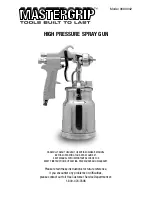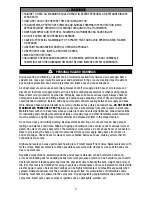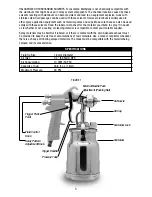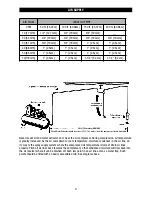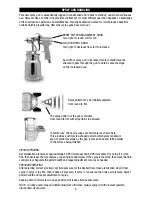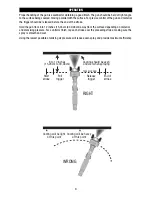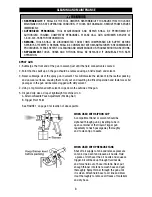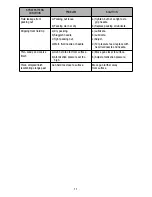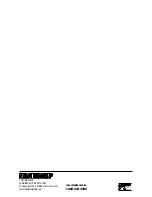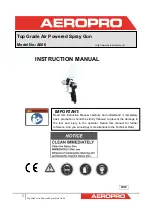
PERSONAL HAZARD WARNINGS
During cleaning and flushing, solvents can be forcefully expelled from fluid and air passages. Some
solvents can cause eye injury. Be sure user and bystanders in the area are wearing impact resistant
eye and face protection. Even small projectiles can injure eyes and cause blindness.
Air under pressure can cause severe injury. Always shut off air supply, drain hose of air pressure and
disconnect tool from air supply when not in use, before changing accessories or when making repairs.
Never direct air at yourself or anyone else. Whipping hoses can cause serious injury. Always check for
damaged or loose hoses and fittings. Never use quick-change couplings at tool. They add weight and
could fail due to vibration. Instead, add a hose whip and connect coupling between air supply and hose
whip, between hose whip and leader hose whip, or between hose whip and leader hose.
DO NOT EXCEED
MAXIMUM AIR PRESSURE OF 90 PSI.
Always use tool a safe distance from other people in work area.
Maintain tools with care. Keep tools clean and oiled for best and safest performance. Follow instructions
for lubricating and changing accessories. Wiping or cleaning rags and other flammable waste materials
must be placed in a tightly closed metal container and disposed of later in the proper fashion.
Do not wear loose or ill-fitting clothing. Remove watches and rings. Do not over reach. Keep proper
footing and balance at all times. Slipping, tripping and falling can be a major cause of serious injury or
death. Be aware of excess hose left on the walking or work surface. Do not abuse hoses or connectors.
Never carry tool by the hose or yank it to disconnect from power supply. Keep hoses from heat, oil
and sharp edges. Check hoses for weak or worn condition before each use, making certain that all
connections are secure.
High sound levels can cause permanent hearing loss. Protect yourself from noise. Noise levels vary with
work surface. Wear ear protectors. When possible secure work with clamps or vise so both hands are
free to operate tool.
Repetitive work motions, awkward positions and exposure vibration can be harmful to hands and
arms. Avoid inhaling dust or handling debris from work processes, which can be harmful to your health.
Operators and maintenance personnel must be physically able to handle the bulk, weight and power of
the tool. This tool is not intended for using in explosive atmospheres and is not insulated for contact with
electric power sources. Solvent and coatings can be highly flammable or combustible especially when
sprayed. Adequate exhaust must be provided to keep air free of accumulations of flammable vapors.
Smoking must never be allowed in the spray area. Fire extinguishing equipmentmust be present in the
spray area. Never spray near sources of ignition such as pilot lights, welders, etc.
2
• FAILURE TO HEED ALL WARNINGS COULD RESULT IN SEVERE PERSONAL OR BYSTANDER INJURY,
EVEN DEATH.
• ONLY USE TOOLS FOR PURPOSE THEY ARE INTENDED FOR.
• YOU MUST WEAR PROTECTIVE EYEWEAR AND SUITABLE RESPIRATORY PROTECTION (OSHA
APPROVED) WHILE SPRAYING OR CLEANING THIS GUN OR ITS ATTACHMENTS.
• NEVER AIM SPRAY GUN AT PEOPLE. SOLVENTS AND THINNERS CAN CAUSE INJURY.
• DO NOT EXCEED RATED OPERATING PRESSURE.
• CAUTION: POTENTIAL FLAMMABILITY OF SPRAYED PAINT, AND AVOID SPRAYING NEAR FLAMES
OR SPARKS.
• USE PAINT MASK/RESPIRATOR WHILE OPERATING PRODUCT.
• USE PRODUCT ONLY IN WELL-VENTILATED AREAS.
• WEAR EAR PROTECTORS.
• HALOGENATED HYDROCARBON SOLVENTS. FOR EXAMPLE: METHYLENE IS NOT CHEMICALLY
COMPATIBLE WITH THE ALUMINUM THAT MIGHT BE USED IN MANY SYSTEM COMPONENTS.

